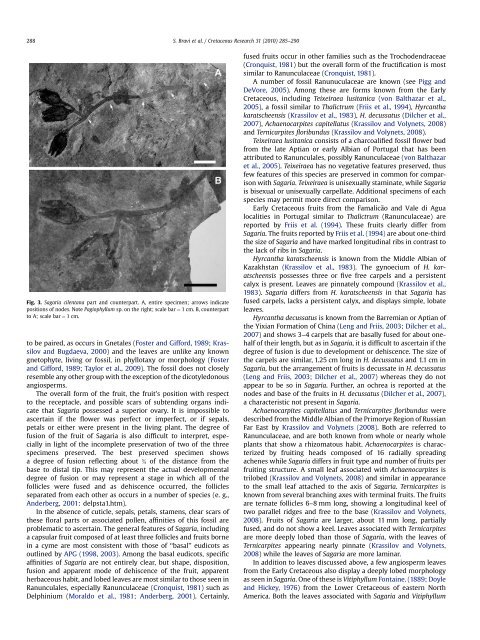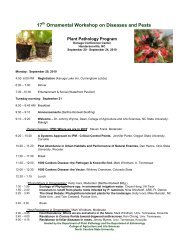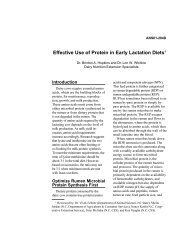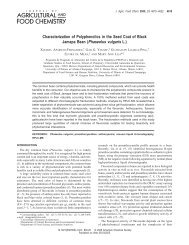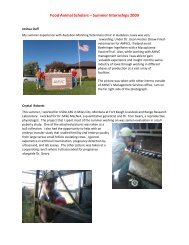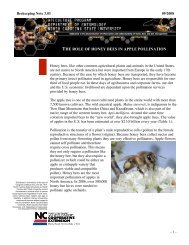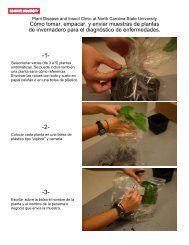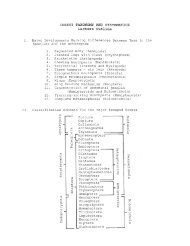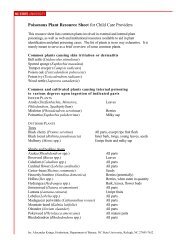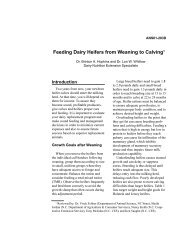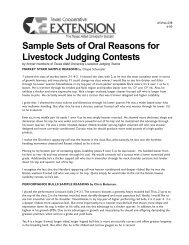Sagaria cilentana gen. et sp. nov.-A New Angiosperm Fructification ...
Sagaria cilentana gen. et sp. nov.-A New Angiosperm Fructification ...
Sagaria cilentana gen. et sp. nov.-A New Angiosperm Fructification ...
Create successful ePaper yourself
Turn your PDF publications into a flip-book with our unique Google optimized e-Paper software.
288<br />
Fig. 3. <strong>Sagaria</strong> <strong>cilentana</strong> part and counterpart. A, entire <strong>sp</strong>ecimen; arrows indicate<br />
positions of nodes. Note Pagiophyllum <strong>sp</strong>. on the right; scale bar ¼ 1 cm. B, counterpart<br />
to A; scale bar ¼ 1 cm.<br />
to be paired, as occurs in Gn<strong>et</strong>ales (Foster and Gifford, 1989; Krassilov<br />
and Bugdaeva, 2000) and the leaves are unlike any known<br />
gn<strong>et</strong>ophyte, living or fossil, in phyllotaxy or morphology (Foster<br />
and Gifford, 1989; Taylor <strong>et</strong> al., 2009). The fossil does not closely<br />
resemble any other group with the exception of the dicotyledonous<br />
angio<strong>sp</strong>erms.<br />
The overall form of the fruit, the fruit’s position with re<strong>sp</strong>ect<br />
to the receptacle, and possible scars of subtending organs indicate<br />
that <strong>Sagaria</strong> possessed a superior ovary. It is impossible to<br />
ascertain if the flower was perfect or imperfect, or if sepals,<br />
p<strong>et</strong>als or either were present in the living plant. The degree of<br />
fusion of the fruit of <strong>Sagaria</strong> is also difficult to interpr<strong>et</strong>, e<strong>sp</strong>ecially<br />
in light of the incompl<strong>et</strong>e preservation of two of the three<br />
<strong>sp</strong>ecimens preserved. The best preserved <strong>sp</strong>ecimen shows<br />
a degree of fusion reflecting about G of the distance from the<br />
base to distal tip. This may represent the actual developmental<br />
degree of fusion or may represent a stage in which all of the<br />
follicles were fused and as dehiscence occurred, the follicles<br />
separated from each other as occurs in a number of <strong>sp</strong>ecies (e. g.,<br />
Anderberg, 2001: delpsta1.htm).<br />
In the absence of cuticle, sepals, p<strong>et</strong>als, stamens, clear scars of<br />
these floral parts or associated pollen, affinities of this fossil are<br />
problematic to ascertain. The <strong>gen</strong>eral features of <strong>Sagaria</strong>, including<br />
a capsular fruit composed of at least three follicles and fruits borne<br />
in a cyme are most consistent with those of ‘‘basal’’ eudicots as<br />
outlined by APG (1998, 2003). Among the basal eudicots, <strong>sp</strong>ecific<br />
affinities of <strong>Sagaria</strong> are not entirely clear, but shape, di<strong>sp</strong>osition,<br />
fusion and apparent mode of dehiscence of the fruit, apparent<br />
herbaceous habit, and lobed leaves are most similar to those seen in<br />
Ranunculales, e<strong>sp</strong>ecially Ranunculaceae (Cronquist, 1981) such as<br />
Delphinium (Moraldo <strong>et</strong> al., 1981; Anderberg, 2001). Certainly,<br />
S. Bravi <strong>et</strong> al. / Cr<strong>et</strong>aceous Research 31 (2010) 285–290<br />
fused fruits occur in other families such as the Trochodendraceae<br />
(Cronquist, 1981) but the overall form of the fructification is most<br />
similar to Ranunculaceae (Cronquist, 1981).<br />
A number of fossil Ranunuculaceae are known (see Pigg and<br />
DeVore, 2005). Among these are forms known from the Early<br />
Cr<strong>et</strong>aceous, including Teixeiraea lusitanica (von Balthazar <strong>et</strong> al.,<br />
2005), a fossil similar to Thalictrum (Friis <strong>et</strong> al., 1994), Hyrcantha<br />
karatscheensis (Krassilov <strong>et</strong> al., 1983), H. decussatus (Dilcher <strong>et</strong> al.,<br />
2007), Achaenocarpites capitellatus (Krassilov and Volyn<strong>et</strong>s, 2008)<br />
and Ternicarpites floribundus (Krassilov and Volyn<strong>et</strong>s, 2008).<br />
Teixeiraea lusitanica consists of a charcoalified fossil flower bud<br />
from the late Aptian or early Albian of Portugal that has been<br />
attributed to Ranunculales, possibly Ranunculaceae (von Balthazar<br />
<strong>et</strong> al., 2005). Teixeiraea has no veg<strong>et</strong>ative features preserved, thus<br />
few features of this <strong>sp</strong>ecies are preserved in common for comparison<br />
with <strong>Sagaria</strong>. Teixeiraea is unisexually staminate, while <strong>Sagaria</strong><br />
is bisexual or unisexually carpellate. Additional <strong>sp</strong>ecimens of each<br />
<strong>sp</strong>ecies may permit more direct comparison.<br />
Early Cr<strong>et</strong>aceous fruits from the Famalicão and Vale di Agua<br />
localities in Portugal similar to Thalictrum (Ranunculaceae) are<br />
reported by Friis <strong>et</strong> al. (1994). These fruits clearly differ from<br />
<strong>Sagaria</strong>. The fruits reported by Friis <strong>et</strong> al. (1994) are about one-third<br />
the size of <strong>Sagaria</strong> and have marked longitudinal ribs in contrast to<br />
the lack of ribs in <strong>Sagaria</strong>.<br />
Hyrcantha karatscheensis is known from the Middle Albian of<br />
Kazakhstan (Krassilov <strong>et</strong> al., 1983). The gynoecium of H. karatscheensis<br />
possesses three or five free carpels and a persistent<br />
calyx is present. Leaves are pinnately compound (Krassilov <strong>et</strong> al.,<br />
1983). <strong>Sagaria</strong> differs from H. karatscheensis in that <strong>Sagaria</strong> has<br />
fused carpels, lacks a persistent calyx, and di<strong>sp</strong>lays simple, lobate<br />
leaves.<br />
Hyrcantha decussatus is known from the Barremian or Aptian of<br />
the Yixian Formation of China (Leng and Friis, 2003; Dilcher <strong>et</strong> al.,<br />
2007) and shows 3–4 carpels that are basally fused for about onehalf<br />
of their length, but as in <strong>Sagaria</strong>, it is difficult to ascertain if the<br />
degree of fusion is due to development or dehiscence. The size of<br />
the carpels are similar, 1.25 cm long in H. decussatus and 1.1 cm in<br />
<strong>Sagaria</strong>, but the arrangement of fruits is decussate in H. decussatus<br />
(Leng and Friis, 2003; Dilcher <strong>et</strong> al., 2007) whereas they do not<br />
appear to be so in <strong>Sagaria</strong>. Further, an ochrea is reported at the<br />
nodes and base of the fruits in H. decussatus (Dilcher <strong>et</strong> al., 2007),<br />
a characteristic not present in <strong>Sagaria</strong>.<br />
Achaenocarpites capitellatus and Ternicarpites floribundus were<br />
described from the Middle Albian of the Primorye Region of Russian<br />
Far East by Krassilov and Volyn<strong>et</strong>s (2008). Both are referred to<br />
Ranunculaceae, and are both known from whole or nearly whole<br />
plants that show a rhizomatous habit. Achaenocarpites is characterized<br />
by fruiting heads composed of 16 radially <strong>sp</strong>reading<br />
achenes while <strong>Sagaria</strong> differs in fruit type and number of fruits per<br />
fruiting structure. A small leaf associated with Achaenocarpites is<br />
trilobed (Krassilov and Volyn<strong>et</strong>s, 2008) and similar in appearance<br />
to the small leaf attached to the axis of <strong>Sagaria</strong>. Ternicarpites is<br />
known from several branching axes with terminal fruits. The fruits<br />
are ternate follicles 6–8 mm long, showing a longitudinal keel of<br />
two parallel ridges and free to the base (Krassilov and Volyn<strong>et</strong>s,<br />
2008). Fruits of <strong>Sagaria</strong> are larger, about 11 mm long, partially<br />
fused, and do not show a keel. Leaves associated with Ternicarpites<br />
are more deeply lobed than those of <strong>Sagaria</strong>, with the leaves of<br />
Ternicarpites appearing nearly pinnate (Krassilov and Volyn<strong>et</strong>s,<br />
2008) while the leaves of <strong>Sagaria</strong> are more laminar.<br />
In addition to leaves discussed above, a few angio<strong>sp</strong>erm leaves<br />
from the Early Cr<strong>et</strong>aceous also di<strong>sp</strong>lay a deeply lobed morphology<br />
as seen in <strong>Sagaria</strong>. One of these is Vitiphyllum Fontaine. (1889; Doyle<br />
and Hickey, 1976) from the Lower Cr<strong>et</strong>aceous of eastern North<br />
America. Both the leaves associated with <strong>Sagaria</strong> and Vitiphyllum


